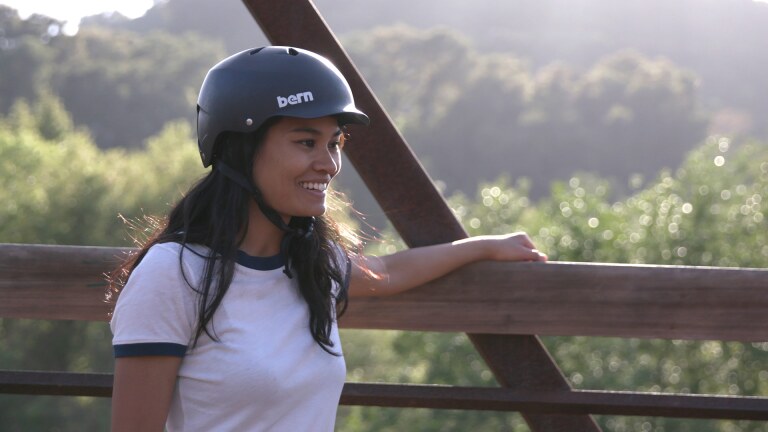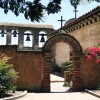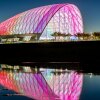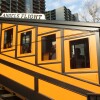8 Car-Free Vacation Destinations on Amtrak's Pacific Surfliner

Amtrak's Pacific Surfliner line is a 351-mile rail route from San Luis Obispo to San Diego — passing through Santa Barbara, Ventura, Los Angeles and Orange Counties along the way, much of the time hugging the Southern California coastline.
Even better? Many of the Amtrak train stations along the Pacific Surfliner route are within walking distance to some of its destinations' most fascinating attractions.
Whether you're traveling coach or business class, you've got your choice of more than a dozen round trips daily between Los Angeles and San Diego alone — with stops in several inland and beach towns along the way.
Given SoCal's strong car culture, it can feel a little uncomfortable to leave your own wheels at home when setting off on an adventure. But there's something so incredibly comfortable about not having to battle traffic, break the bank when filling up the tank or worry about where to make a pit stop for diaper changes or adults who just can't hold it in for very long.
On the Pacific Surfliner, you can just sit back in your reclining seat, charge your phone or laptop and watch the world go by from either the bottom or the top level of the double-decker train.
So, pack a lunch or grab a snack on board, wear good walking shoes — and if you're interested in two-wheeling your way through your destination, bring your bicycle on board! You can even carry on surfboards, golf clubs, fishing poles and other large items in lieu of luggage. (And you can always check them with a baggage attendant.)
Traveling with a furry friend? Add a pet reservation for your small dog or cat to your coach class trip for a fee (or Amtrak Guest Rewards points) each way. (Qualified service animals are always welcome onboard for free.)
For the most flexibility, purchase your tickets in advance online or at an Amtrak station. Much-appreciated fare discounts are also available for kids, students, military personnel, veterans, seniors and more.
Whether you're looking for a quick beach getaway, a historic adventure or a family vacation without the minivan, here's a guide to the ultimate SoCal train excursion — including where to go, what to do when you get there and how to get around once your feet wear out.
1. San Luis Obispo, Central Coast






Along this coastal route to the northernmost stop on the Pacific Surfliner, San Luis Obispo, you'll pass through the Vandenberg Air Force Base, perhaps offering a glimpse of what SpaceX might be up to. And once you arrive at SLO, you don't even have to leave the depot to begin your adventure!
Start off at the San Luis Obispo Railroad Museum, located in the circa 1894 freight house of the Southern Pacific Railroad, right at the end of the platform. Inside the museum, you'll find a time capsule of 19th- and 20th-century railroading — whether passenger or freight, public or private. And outdoors, you can find a historic caboose, boxcars, pushcars and a circa 1926 Pullman café observation car.
Walk less than a mile to the core of SLO's downtown, where you can explore — or even contribute to — the utterly disgusting Bubblegum Alley. It's part communal art project, part oddball tourist attraction, located in a narrow pedestrian passage off Higuera Street between Garden and Broad streets. The surrounding blocks are also home to a children's museum, art museum and history center — the latter of which offers both guided walking tours and downloadable self-guided walking tour itineraries of the immediate surrounding area and beyond.
Also about a dozen blocks away from the SLO train station is the Mission San Luis Obispo de Tolosa, established by Franciscan padre Junípero Serra in 1772. You could spend at least a couple of hours there, admiring the garden and the original bronze mission bells on display — and maybe even taking in a mass. Docent-led tours are offered daily at 1:15 p.m., except Sundays when they take place at 2 p.m. As you explore, keep your eyes open for where people are actually buried both in the floor and the walls.
Amtrak offers a discount on tickets purchased for traveling to and/or from SLO via the Pacific Surfliner as part of the San Luis Obispo Car Free Program. To go farther afield, show your Pacific Surfliner ticket for a free transfer on San Luis Obispo Regional Transit Authority (SLORTA) and SLO Transit buses, which could take you as far as Morro Bay or even Cambria and Hearst Castle.
2. Santa Barbara, Central Coast
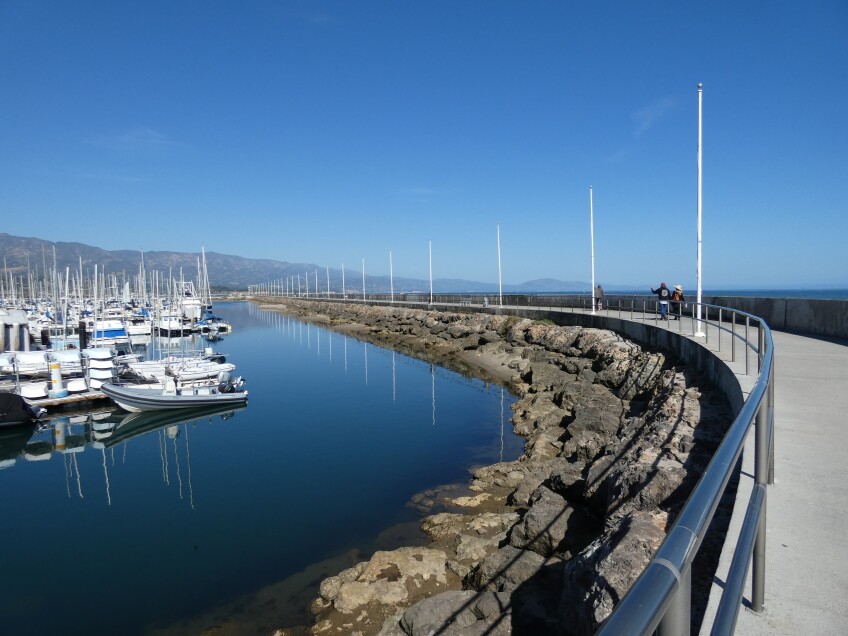



You can't get more centrally located in Santa Barbara than where you'll disembark from the Pacific Surfliner. Next door to the train depot on State Street is the Reagan Ranch Center, where history buffs can brush up on their Ronald Reagan trivia and see a section of the Berlin Wall before heading to The Funk Zone, a.k.a. the "funky" area of downtown Santa Barbara that's bursting with art, shopping, wine tasting rooms and eateries.
Or, hoof it down State Street all the way to the Dolphin Fountain at Cabrillo Boulevard and enter Stearns Wharf — one of Santa Barbara's two popular harbor destinations. There, you can grab some seafood or hop on one of the scenic coastal cruises offered by Celebration Cruises. If you've got kids in tow, they'll love the Lil' Toot — a tiny tugboat-turned-water taxi (with a smiley face painted on its bow) that shuttles passengers between Stearns Wharf and Santa Barbara Harbor, where you can walk the breakwater or visit the Santa Barbara Maritime Museum. Advance tickets are recommended, as space on the boat is limited.

If inland attractions are more appealing to you, walk a little over a mile to Santa Barbara's circa 1929 Spanish Colonial Revival-style courthouse, whose picturesque Mural Room, Sunken Garden and Clock Tower are open for self-guided tours to members of the public visiting the courthouse on non-official business. (Santa Barbara County Courthouse Docent Council will soon resume its docent-led tours of the spaces.)
All courthouse visitors are subject to a security screening and current face covering requirements.
Amtrak offers a discount on tickets purchased for traveling to and/or from Santa Barbara via the Pacific Surfliner as part of the Santa Barbara Car Free program. To go farther afield, show your Pacific Surfliner ticket for a free transfer on Santa Barbara Metropolitan Transit District buses or one of the Downtown and Waterfront Shuttles (although service for the latter is temporarily suspended for the COVID-19 pandemic).
3. Carpinteria, Central Coast




Riding the rails and going car-free could give you the perfect excuse to explore a hidden gem of Santa Barbara County: Carpinteria. Less than a half-mile from the train station is the free Carpinteria Valley Museum of History, whose exhibit galleries focus on local history including the indigenous people who once called the area home, as well as later colonists and pioneers.
To experience Carpinteria's natural history first-hand, walk less than a half-mile from the depot to the Ash Avenue entrance of Carpinteria Salt Mash Nature Park — a crucial wetland habitat that's partially used for research by the University of California and partially open to the public, thanks to the Land Trust for Santa Barbara County. The public trail — which is open during daylight hours — is just a quarter-mile long, giving you a tiny glimpse of this this 230-acre reserve, which is still undergoing habitat restoration efforts.
Carpinteria State Beach is also within easy walking distance — but if you've got a spring in your step (or a bicycle at your disposal), it's well worth traveling 2 miles from the train station to the Carpinteria Bluffs Nature Preserve. From atop the bluffs, you can watch the harbor seals in the Carpinteria Seal Sanctuary at a safe distance — which is especially important between December and the end of May, when the rookery area beach is closed for pupping season. If your feet are failing you, transfer for free at the train station to the Santa Barbara Metropolitan District Route 20/Carpinteria Line bus, which can also take you to the seal preserve.
For an even wilder experience, the weird and sticky Tar Pits Park is located between Carpinteria State Beach and Carpinteria Bluffs Nature Preserve. It's part of Carpinteria's "Oil Seeps," which could be as much as 2.5 million years old. Natural tar deposits from this "asphalt lake" erupt to the surface and bulge out in hulking, black tar gobs that once helped seal Chumash boats and baskets — and pave Carpinteria's roads. Bring a pair of sacrificial shoes you don't mind getting gooey, or pack some oil to remove tar from your skin and shoes.
4. Ventura, Central Coast

The Pacific Surfliner drops its passengers off practically on the doorstep of the Ventura County Fairgrounds (a good option for visiting the Fair, which runs August 3 to 14 this year) and Ventura Raceway — but those aren't the only attractions easily reachable from the Ventura train depot. For example, the City of Ventura's downloadable Historic Walking Tour brochure will guide you to many of the historic sites of Downtown Ventura — including City Hall (formerly the county courthouse), the city's first post office, historic theatres and hotels, and the Old Mission Basilica San Buenaventura.
Less than a half-mile walk from the train, the mission was the ninth of the Spanish missions to be founded in California — and the last to be established by Junípero Serra, in 1782. Over the last two-plus centuries, this "Mission by the Sea" has survived multiple earthquakes (and resulting tidal waves), the threat of a pirate attack in 1818, and even secularization in 1836. The mission also includes ruins of the former Mission Aqueduct that once brought water from the Ventura River – including a filtering tank and remnants of the original Zanja.

If you're feeling really ambitious — and don't mind an uphill climb — head to Ventura Botanical Gardens in the hills above city hall, where you'll find one of the best ocean views for miles. Although it was forcibly closed for nearly a year after getting scorched in the devastating Thomas Fire at the end of 2017, it's been replanted and has bounced back — despite nearly every plant (6,000 or more) having perished in the wildfire.
Head up the Botanical Garden Trail to enjoy Mediterranean climate-friendly plants in the California Natives, South African Cape and Chilean gardens. The complete development of its 107 acres — particularly in the upper gardens — won't be completed until 2050. But there's still plenty to see, especially in the lower gardens. And the higher you go, the more you'll cool off thanks to those ocean breezes, which make this a comfortable visit even in the middle of summer.
To go farther afield, show your Pacific Surfliner ticket for a free transfer onVentura County Transportation Commission and Gold Coast Transit buses.
5. Irvine, Orange County
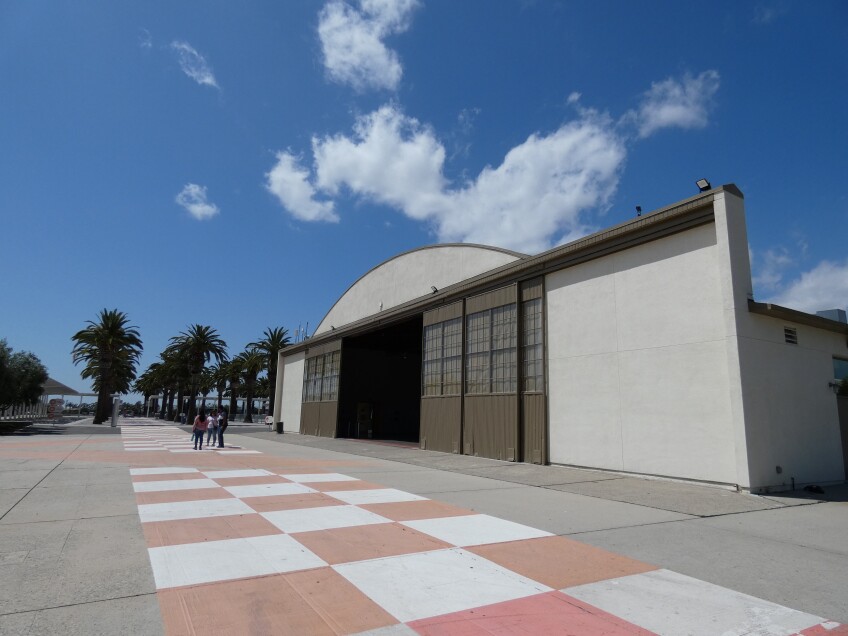
Concertgoers are more than familiar with the Irvine stop on the Pacific Surfliner (also part of the Metrolink commuter line) for its proximity to FivePoint Amphitheatre, built on the former site of Irvine Meadows Amphitheatre (which was demolished in 2016). And while the city of Irvine has plenty of other attractions to offer solo travelers and families alike, the destination that's closest to the train station — Great Park — is also one that could entertain you all day.
Built on 1,300 acres of the former Marine Corps Air Station "El Toro" (which operated from 1943 to 1999), 450 acres of the park have been developed so far — with an additional 230 acres still in progress. Make your first stop the Great Park Visitors Center, where you can get oriented with a park map, make a pit stop at a restroom and pick up any extra snacks before heading to one of the many sports facilities — including soccer fields, baseball diamonds, softball fields and basketball courts — or other play areas that will surely tire the kids out.

The Visitors Center is where you can also get your free boarding pass for the big orange tethered balloon ride — one of the largest such rides you'll find anywhere, and the first of its kind in the U.S. The balloon ride, which soars to 400 feet above the ground, is open mornings, afternoons and evenings Thursday through Sunday (with a temporary closure between 3 and 7 p.m.). Ride availability depends on proper flight conditions — so to check the local weather and status of the balloon, you can call ahead at 949-724-6247.
Also at the Visitors Center, you can purchase single tickets or an all-day ride pass for the Great Park Carousel, which runs Thursdays and Fridays from 10 a.m. to 10 p.m. and weekends from 9 a.m. to 10 p.m. You won't find just horses on this menagerie-style carousel — but also a panda, a tiger, a wild boar and more.

From the carousel, follow the Walkable Historical Timeline to learn about military affairs in the time that this site was used by the Marines — and then head to Hangar 244, built in 1944 during World War II and restored as an historical exhibit gallery. From there, you can continue on to the Palm Court Arts Complex, where the Great Park Gallery and Artist Studios have hosted free art openings and exhibits in repurposed military buildings since 2011. You'll find a number of Canary Island palm trees in the courtyard, as well as a vintage airplane static display and blue glass outlines of "ghost" buildings (which have been demolished).
To go farther afield, show your Pacific Surfliner ticket for a free transfer on Orange County Transportation Authority and iShuttle buses.
6. San Clemente, Orange County






Take the Pacific Surfliner to San Clemente's train station at 615 Avenida Victoria, located practically at the entrance to the 1300-foot-long San Clemente Pier (circa 1928, renovated in 2009) along the city's 2.3-mile-long beach trail. From there, you can stay and enjoy the beach or walk up Avenida Victoria (which turns into Avenida del Mar, a main thoroughfare) to Casa Romantica Cultural Center and Gardens — once the 15-room family home of San Clemente founder Ole Hanson, who envisioned creating a "Spanish Village by the Sea."
Casa Romantica — which Hanson called "Hacienda San Clemente" — offers a nice example of the "old Spain elegance" that influenced the streetscapes of the rest of San Clemente. The historic home museum, art gallery and 2.5 acres of gardens are open to the public daily except Mondays and federal holidays. Admission is free the first Sunday of the month.
More Spanish Colonial Revival-style buildings can be found throughout the nationally-recognized historic district of San Clemente's North Beach — which you can reach by walking a mile up the beach, taking the Metrolink train one stop north (to the other San Clemente train platform) or, in the summertime, by hopping on the free trolley. Closest to the North Beach shoreline is the circa 1928 Ole Hanson Beach Club — which, after a $6 million refurbishment, is now open for special event rentals. It stands as a recognizable coastal landmark of the area.

Just beyond the beach club is the San Clemente Casino, which has been restored to its circa 1937 glory. Like the Catalina Casino building, it was created as a community gathering place and music hall/dancehall. Today, it's once again open to the public for ticketed musical performances (and is also available to rent for special events). You can also enjoy the Casino atmosphere at its adjacent Parisian bistro, Moulin, which is open for breakfast and lunch daily from 8 a.m. to 3 p.m.
Finally, head on up to El Camino Real at the northern gateway of San Clemente to take a peek at the progress on renovation of the old Miramar Theater (formerly San Clemente Theatre, built in 1937) — which is currently being transformed into a multi-use facility that will include a food hall. While you're soaking in the 1920s and 1930s coastal vibes, take a load off at Landers Liquor Bar, which is located in the historic former Aquarium Café building (circa 1931) that's also part of the historic district.
To go farther afield, show your Pacific Surfliner ticket for a free transfer on Orange County Transportation Authority buses.
7. Old Town San Diego


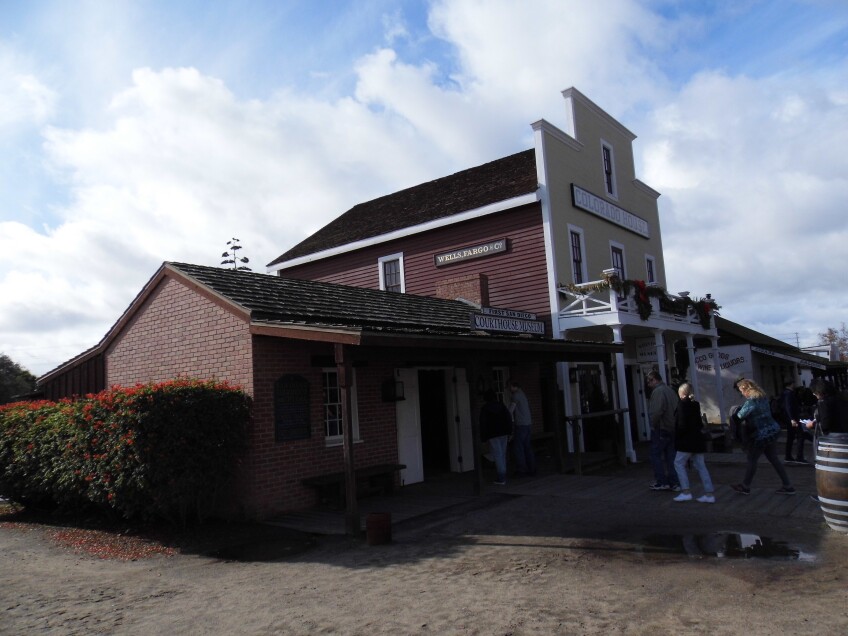



San Diego has two Pacific Surfliner stops — and the northernmost one offers easy access to all of the wonderful cultural attractions of Old Town San Diego State Historic Park, most of which are open Thursdays through Sundays, except Thanksgiving, Christmas Day and New Year's Day. (Check with each individual attraction before arriving to confirm.) To plan your time in Old Town, consult the written self-guided tour on the State Parks website, which recommends how to spend anywhere from an hour to a full day there; or, pick up a self-guided tour brochure at the Robinson-Rose Visitor Center in the center of the park.
Of course, you could always chart your own course, popping into whichever museums, historic homes and landmarks you may come across — including the Church of the Immaculate Conception, the Mason Street School Museum, the circa 1851 former home ofThe San Diego Unionnewspaper, and rebuilt versions of the first San Diego courthouse and the Steely Stable Barn. On the porch of the Colorado House, State Park Interpreters give free, 15-minute Hidden History Talks most Fridays, Saturdays and Sundays at 2 p.m.
Also ripe for exploring is La Casa de Estudillo — a large adobe townhouse dating back to California's Mexican and early American periods of the 19th century. Around the turn of the last century, sugar magnate and local developer John D. Spreckels transformed the then-abandoned adobe into a tourist attraction based on Helen Hunt Jackson's famous novel Ramona — "Ramona's Marriage Place," which was open to the public until the 1960s. Today, the Casa is the only attraction in Old Town listed on its own on the National Register of Historic Places.

If you're looking to spend the night in Old Town, try to get a room at The Cosmopolitan Hotel and Restaurant — built from 1827 to 1829 as the home of cattle rancher Juan Bandini. In 1869, Albert Seely converted it into a stagecoach stop and hotel. It changed hands many more times before being purchased by the State of California in 1968, the same year that Old Town became a state park. A 2010 restoration returned it to its circa 1870s grandeur — and although its fine dining restaurant is temporarily closed, there are plenty of other (primarily Mexican) dining options with an old world feel throughout the Old Town area.
To go farther afield, visit the Pacific Surfliner Café car during your train ride to purchase a discounted one-day pass for San Diego Metropolitan Transit System (MTS), whose trolley lines can take you to the Mexican border at San Ysidro, the Gaslamp Quarter, Petco Park for a Padres game, the Convention Center, Barrio Logan and more throughout San Diego. Connection is available to the Green and Blue Line trolleys at Old Town Transit Center.
8. San Diego

Arrive in the heart of San Diego at the Santa Fe Depot — the southernmost terminus of the Pacific Surfliner line, which brings you to a nexus of San Diego's "New Town" with convenient walking access to Downtown San Diego, the Gaslamp Quarter, Little Italy, the harbor area and Embarcadero, Seaport Village and more.

Head west on Ash Street to reach Waterfront Park, with the circa 1938 San Diego County Administration Center as its centerpiece. Until 2014, the area surrounding the county building had been a giant parking lot — but since that time, it's been developed into a whimsical playground with sculptures by French-San Diegan self-trained artist Niki de Saint Phalle (currently on loan from the Niki Charitable Art Foundation) and several kid-friendly (and splash-worthy) water features, powered by an underground pumping station and water treatment plant.
Directly across Harbor Drive from Waterfront Park is the Maritime Museum of San Diego and its collection of historic vessels and reproductions — including the world's oldest active sailing ship, the Star of India, as well as the circa 1898 steam ferry boat Berkeley, relocated after 60 years of service on the San Francisco Bay. Both of these are national landmarks, as are the circa 1914 Pilot Boat (which helped direct thousands of major commercial ships entering and leaving the San Diego Bay) and the Vietnam-era Swift Boat. On weekends, you can take a narrated Naval History Tour aboard the Swift Boat, which travels under the Coronado Bridge and past Navy installations and shipyards both on the mainland and on Coronado Island.




Continue your Navy time travel by grabbing a drink or a snack — or even spending the night — at the former Army Navy YMCA in Downtown, now open as The Guild boutique hotel. Originally built in 1924 to offer recreation and dormitories to locally-stationed Armed Services personnel looking to spend their off-duty time off-base. It's been updated for the modern traveler — but you can still spot historic elements like original tile and windows, exposed concrete ceiling beams, and its Romanesque-style façade. Other historic lodging options within short walking distance from the Pacific Surfliner station include the nationally landmarked circa 1910 U.S. Grant Hotel (named after Ulysses S. Grant by his son, Ulysses S. Grant Jr., who oversaw construction) and the former home of the San Diego Trust and Savings Bank, built in 1928 and now the Marriott Courtyard San Diego Downtown hotel.
To go farther afield, visit the Pacific Surfliner Café car during your train ride to purchase a discounted one-day pass for San Diego Metropolitan Transit System (MTS), whose trolley lines can take you to the Mexican border at San Ysidro, Old Town, UC San Diego, Barrio Logan and more throughout San Diego. Connection is available to the Green Line trolley at Santa Fe Depot and to the Blue Line a short walk away at American Plaza.
For updates on COVID-19 safety protocols and passenger requirements, visit the Pacific Surfliner website.
